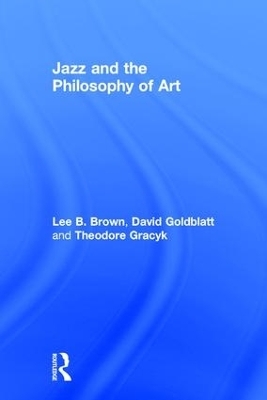
Jazz and the Philosophy of Art
Routledge (Verlag)
978-1-138-24135-0 (ISBN)
Co-authored by three prominent philosophers of art, Jazz and the Philosophy of Art is the first book in English to be exclusively devoted to philosophical issues in jazz. It covers such diverse topics as minstrelsy, bebop, Voodoo, social and tap dancing, parades, phonography,
musical forgeries, and jazz singing, as well as Goodman’s allographic/autographic distinction, Adorno’s critique of popular music, and what improvisation is and is not.
The book is organized into three parts. Drawing on innovative strategies adopted to address challenges that arise for the project of defining art, Part I shows how historical definitions of art provide a blueprint for a historical definition of jazz. Part II extends the book’s commitment to social-historical contextualism by exploring distinctive ways that jazz has shaped, and been shaped by, American culture. It uses the lens of jazz vocals to provide perspective on racial issues previously unaddressed in the work. It then examines the broader premise that jazz was a socially progressive force in American popular culture. Part III concentrates on a topic that has entered into the arguments of each of the previous chapters: what is jazz improvisation? It outlines a pluralistic framework in which distinctive performance intentions distinguish distinctive kinds of jazz improvisation.
This book is a comprehensive and valuable resource for any reader interested in the intersections between jazz and philosophy.
Lee B. Brown was Professor of Philosophy at The Ohio State University and a specialist in the history of modern philosophy, general aesthetics, and the philosophy of music. Contemporaneously, he also worked as a professional jazz critic in Columbus, Ohio. His publications span 45 years in major philosophy journals. With David Goldblatt, he was co-editor of the highly successful textbook Aesthetics: A Reader in Philosophy of the Arts, now in its 4th Edition (Routledge, 2017) David Goldblatt is Emeritus Professor of Philosophy at Denison University and the author of Art and Ventriloquism (2006) in the Routledge series Critical Voices in Art, Theory and Culture. He is co-editor of Aesthetics: A Reader in Philosophy of the Arts, with Lee B. Brown and Stephanie Patridge, now in its 4th edition (Routledge, 2017) and is co-editor with Roger Paden of The Aesthetics of Architecture: Philosophical Investigation into the Art of Building (2011). Theodore Gracyk is Professor of Philosophy at Minnesota State University Moorhead and, since 2013, co-editor of the Journal of Aesthetics and Art Criticism. His book I Wanna Be Me: Rock Music and the Politics of Identity (2001) was selected as co-winner of the 2002 Woody Guthrie Award and he is the author of four other books on the aesthetics of music, as well as co-editor of two books, including The Routledge Companion to Philosophy and Music (2011).
Foreword - Lee Brown: A Recollection
Acknowledgements
Introduction
PART I How is Jazz Distinctive? Essence and Definition
1 Dancing, Dwelling, and Rhythmic Swing
2 A Theory of Jazz Music: "It Don't Mean a Thing ..."
3 Defining Jazz Historically
PART II Jazz and American Culture
4 Jazz Singing and Taking Wing
5 Race, Jazz, and Popular Music: The Legacy of Blackface Minstrelsy
6 Jazz and the Culture Industry
PART III Music Ontology
7 Improvisations and Spontaneity
8 Musical Forgeries, Improvisation, and the Principle of Continuity
9 Phonography, Repetition, and Spontaneity
10 Jazz Improvisation and its Vicissitudes: A Plea for Imperfection
Index
| Erscheinungsdatum | 13.06.2018 |
|---|---|
| Verlagsort | London |
| Sprache | englisch |
| Maße | 152 x 229 mm |
| Gewicht | 566 g |
| Themenwelt | Kunst / Musik / Theater ► Musik ► Jazz / Blues |
| Geisteswissenschaften ► Philosophie | |
| Sozialwissenschaften ► Kommunikation / Medien ► Medienwissenschaft | |
| ISBN-10 | 1-138-24135-0 / 1138241350 |
| ISBN-13 | 978-1-138-24135-0 / 9781138241350 |
| Zustand | Neuware |
| Haben Sie eine Frage zum Produkt? |
aus dem Bereich


